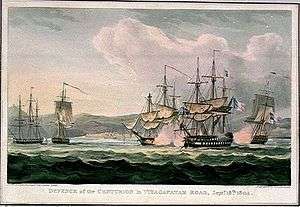French ship Jean-Jacques Rousseau (1795)
 Capture of Marengo (ex-Jean-Jacques Rousseau, left) by HMS London (right) | |
| History | |
|---|---|
| Name: | Jean-Jacques Rousseau |
| Builder: | Toulon |
| Laid down: | September 1794 |
| Launched: | 21 July 1795 |
| Commissioned: | October 1796 |
| Renamed: | Marengo, 2 December 1802 |
| Captured: | By HMS London, 13 March 1806 |
| Name: | Marengo |
| Acquired: | 13 March 1806 |
| Fate: | Broken up, 1816 |
| General characteristics [1] | |
| Class and type: | Téméraire-class ship of the line |
| Displacement: |
|
| Length: | 55.87 metres (183.3 ft) (172 pied) |
| Beam: | 14.90 metres (48 ft 11 in) |
| Draught: | 7.26 metres (23.8 ft) (22 pied) |
| Propulsion: | Up to 2,485 m2 (26,750 sq ft) of sails |
| Armament: |
|
| Armour: | Timber |
Jean-Jacques Rousseau was a Téméraire class 74-gun ship of the line of the French Navy, active during the French Directory, French Consulate and First French Empire. Renamed Marengo in 1802, she took part in Linois' operations in the Indian Ocean before her capture by the Royal Navy.
Career
Construction of Jean-Jacques Rousseau began in September 1794 at Toulon, and she was launched on 21 July 1795. In October 1796, under Captain Racord, she was part of the Villeneuve's squadron that sailed from Toulon to Brest.
On 2 December 1802, she was renamed to Marengo, reflecting the political change away from the Revolutionary Republic inspired by Jean-Jacques Rousseau towards the advent of General Bonaparte. On 6 March 1803, she departed Brest as the flagship of a squadron under Admiral Linois, set to take possession of Pondicherry, which the Treaty of Amiens had attributed to France. The squadron also comprised the frigates Belle Poule, Atalante and Sémillante, along with two troopships carrying 1350 soldiers under General Decaen.
From May 1803, tensions rose between France and England. Linois' squadron arrived at Pondicherry on 11 July, where the 64-gun HMS Trident and the sloop Rattlesnake lied at anchor. British authorities delayed the transfer until the French brig Bélier arrived with news that the War of the Third Coalition was about to break out in Europe. Finding his squadron vulnerable to a surprise attack, Linois made a dramatic night escape to Isle de France.
War eventually broke out in September, and Linois reinforced French guarrisons at La Réunion and Batavia, and then set out to prey upon British trade in the Indian Ocean, using Marengo as a large cruiser. In October, after Atalante to a mission to Muscat, he headed for the Dutch East Indies with Belle Poule and Sémillante, where he expected to find supplies. On his way, he raided the British settlement at Bengkulu, capturing two merchantmen; 5 others were scuttled by fire by their own crews to avoid capture. At Batavia, Linois found little support from the Dutch authorities.
In early 1804, Linois attempted to intercept a large convoy of Honourable East India Company (HEIC) East Indiamen, leading to the Battle of Pulo Aura. The British commander, Commodore Dance, led a vigorous defence and Linois, feeling isolated away from supplies and repairs and unwilling to risk attrition, chose to withdraw. The news of Linois' failure further discredited him at Batavia, and the growing reluctance of the Dutch to provide support to his squadron forced him to return to Isle de France.

In September, Linois attempted another raid against a merchant convoy, leading to the Battle of Vizagapatam. British Rear-Admiral Peter Rainier had replaced the small frigate HMS Wilhelmina with the 50-gun HMS Centurion. Although Centurion was not a match for Marengo, she skillfuly used her lower draught to keep Marengo at bay in the shallow waters. There again Linois hesitated to commit his forces and withdrew after a four-hour exchange that left Marengo in need to six month worth of repairs.
In March 1806, Linois set out to return to France with Marengo and Belle Poule, and prey upon British shipping between St. Helena and the Canary Islands on his way home. On 13 March, he detected a group of ship, and sailed in pursuit of what he believed to be a convoyw; it was in fact the division of Vice-Admiral Sir John Warren, with seven ships of the line (including the 90-gun London, the 74-gun Ramillies and Repulse, and the 80-gun Foudroyant), two frigates (including the 36-gun Amazon) and one corvette. In the ensuing Action of 13 March 1806, a fierce duel opposed London and Marengo, which eventually struck her colours; Belle Poule battled against Amazon and later against Ramilles, and had to surrender as well.
Marengo was taken into British service as HMS Marengo. She was used as a prison hulk from 1809 until she was broken up in 1816.
Sources and references
References
- ↑ Clouet, Alain (2007). "La marine de Napoléon III : classe Téméraire - caractéristiques". dossiersmarine.free.fr (in French). Retrieved 4 April 2013.
Sources
- Roche, Jean-Michel (2005). Dictionnaire des bâtiments de la flotte de guerre française de Colbert à nos jours 1 1671 - 1870. ISBN 978-2-9525917-0-6. OCLC 165892922.
- The Campaign of Trafalgar : 1803-1805. Robert Gardiner, ed. Chatham Publishing, 1997. ISBN 1-86176-028-0
- C. Northcote Parkinson. Britannia Rules. Gloucester, 1987. Qu. By: The Campaign of Trafalgar: 1803-1805 ... p.26
- The Victory of Seapower. Winning the Napoleonic War 1806-1814. Robert Gardiner, ed. Chatham Publishing, 1998. p. 28-29. ISBN 1-86176-038-8